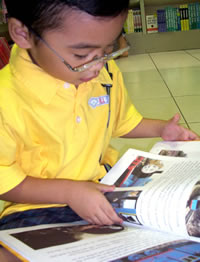Help for Young Readers
Living in the modern world requires a high standard of literacy. As we gain access to more and more information, the ability to read text, understand its meaning and know its implications has become almost indispensable. Readers today need not only to be efficient and selective but critical in their reading. As a result, teaching children to read has become a priority for schools all over the world.

The above has been a key issue for Singapore’s Ministry of Education (MOE) as well. According to our English Language Syllabus (2001), schools are required to have a reading programme that gives students the skills to make sense of print, provides enjoyable reading experiences, and pushes them to become independent critical readers.
However, fulfilling these objectives in the classroom has remained a challenge for many teachers.
A series of research studies done by the Centre for Research in Pedagogy and Practice (CRPP) shows that reading lessons in Singapore schools are mostly about extracting information from text in order to complete required worksheets. Students are often not encouraged to wander beyond the text or develop a sense of inquiry or research.
The Reading Intervention Model
The School-Based Reading Intervention Model (SBRIM) aims to address these concerns by using the latest research findings and components from internationally successful reading instruction programmes to help teachers teach students to read effectively. It sets itself apart from other reading models used in Singapore by emphasising the need for children to be immersed in the world of books, develop a reading culture and be explicitly instructed on reading and comprehension skills.
“Teachers read books to kids as an optional extra rather than a fundamental part of the English Language curriculum,” explains Dr Chitra Shegar, the project’s main Principal Investigator. “When they do read aloud, the emphasis is often on decoding and surface comprehension of text. There is very little global comprehension of the text and interaction with the text itself.”
The research team hopes that the reading of stories and other non-fictional texts will not only develop literacy, but also a passion for reading as a lifelong habit. “The project has been designed in such a way that reading is not only seen as a skill to be taught but a habit to be caught,” adds Dr Shegar. This, in addition to the explicit instruction of reading and comprehension skills, would bring reading instruction to a new level in Singapore. The model is described in Figure 1.
Figure 1: Components of the SBRIM
How does it work?
Currently, the SBRIM is being implemented in collaboration with Primary 1 teachers in a primary school in Singapore. It will be conducted over a period of 4 years and comprises two phases.
The first phase spans the first 2 years of the study. Here, a reading expert will act as a coordinator and work with teachers through a series of hands-on workshops. These workshops are important for them to gain the “procedural knowledge” necessary to translate the reading model into actual practice. Dr Shegar defines this knowledge as not only including an understanding of theory and practice of reading instruction, but also “the confidence, intuition and flexibility to know what are suitable and likely to work with a group of students.”
Following these workshops, the teachers and coordinator will work together to incorporate what has been learnt in the workshops into the reading curriculum. The coordinator may also co-teach with teachers in order to facilitate the process.
At the same time, teachers will form a study group where they can share problems or knowledge gained from reading the literature. Meetings will also be facilitated by the coordinator, and the time spent in the study group will be counted towards the teachers’ professional development hours.
The second phase of the model will take place during the third and fourth years of the research study. This time, the coordinator will “retreat to the background” and allow teachers to take charge in implementing and developing a curriculum based on the model.
Looking ahead
Currently, the SBRIM is still in its first year of implementation, with researchers wrapping up the collection of baseline data. In line with the first phase of the study, teachers have also begun attending professional development courses to further develop their knowledge of literacy instruction.
Dr Shegar and her team now hope to get teachers to try more effective teaching methods and reflect on their own classroom practices. And while the model has a long way to go before significant changes can be made in the classroom, the response from teachers as well as the school has been extremely positive which certainly affords reason for optimism.
Other related projects:
> Teaching Reading in Singapore Primary Schools
> Independent Variables that Impact Literacy and Reading Habits
Also read:
> Describing and Improving the Teaching of Reading in Singapore Primary Schools






